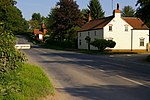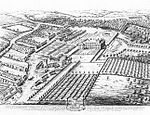Bigger Trees Near Warter
2007 paintingsCollection of the Tate galleriesLandscape paintingsPaintings by David HockneyPocklington ... and 2 more
Use British English from September 2013Yorkshire in art
Bigger Trees Near Warter or ou Peinture en Plein Air pour l'age Post-Photographique is a large landscape painting by British artist David Hockney. Measuring 460 by 1,220 centimetres or 180 by 480 inches, it depicts a coppice near Warter, Pocklington in the East Riding of Yorkshire and is the largest painting Hockney has completed.It was painted in the East Riding of Yorkshire between February and March 2007. The painting's alternative title alludes to the technique Hockney used to create the work, a combination of painting out of doors and in front of the subject (called in French ‘sur le motif’) whilst also using the techniques of digital photography.
Excerpt from the Wikipedia article Bigger Trees Near Warter (License: CC BY-SA 3.0, Authors).Bigger Trees Near Warter
Geographical coordinates (GPS) Address Nearby Places Show on map
Geographical coordinates (GPS)
| Latitude | Longitude |
|---|---|
| N 53.9399556 ° | E -0.6383314 ° |
Address
YO25 9DB , Warter
England, United Kingdom
Open on Google Maps








